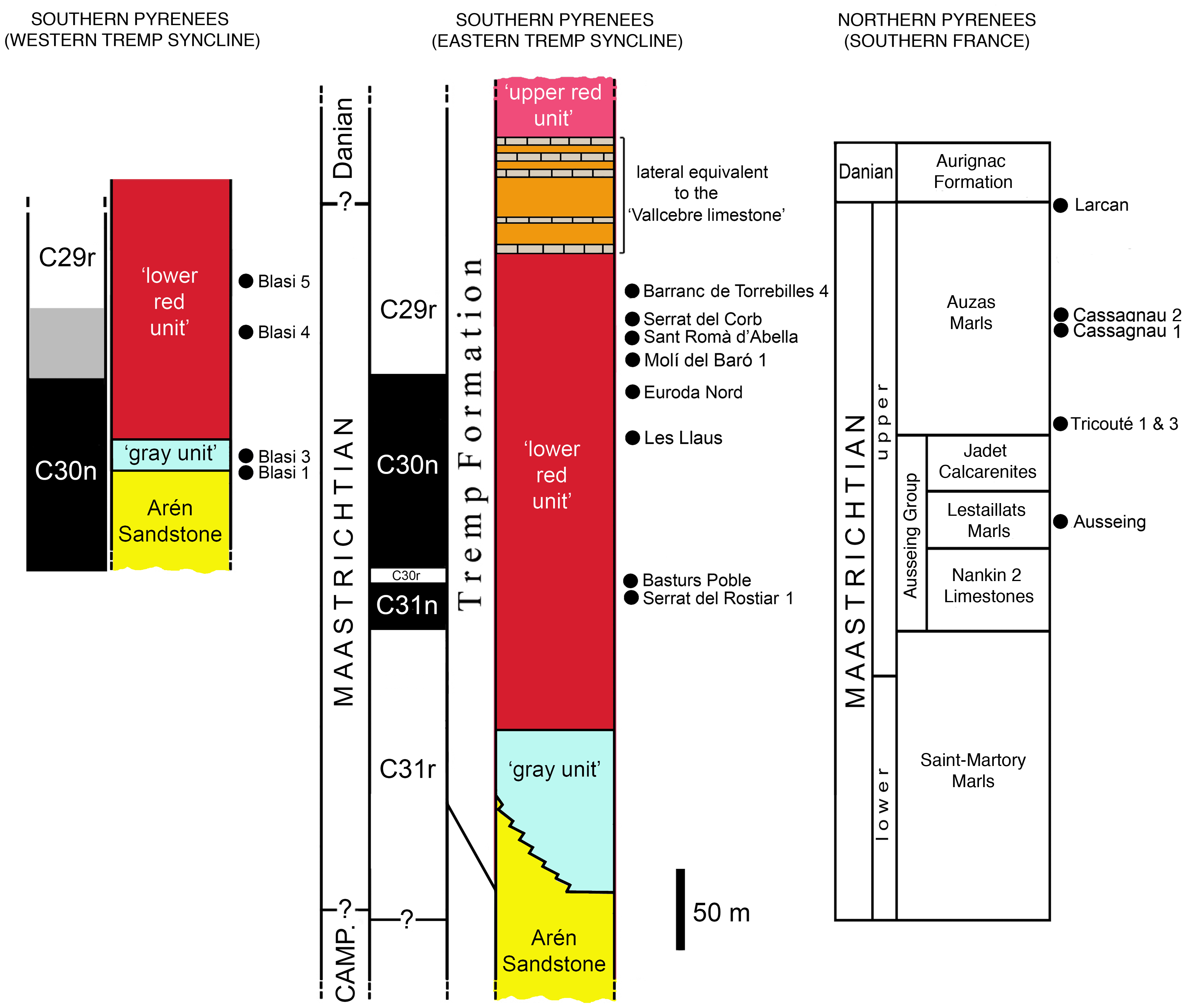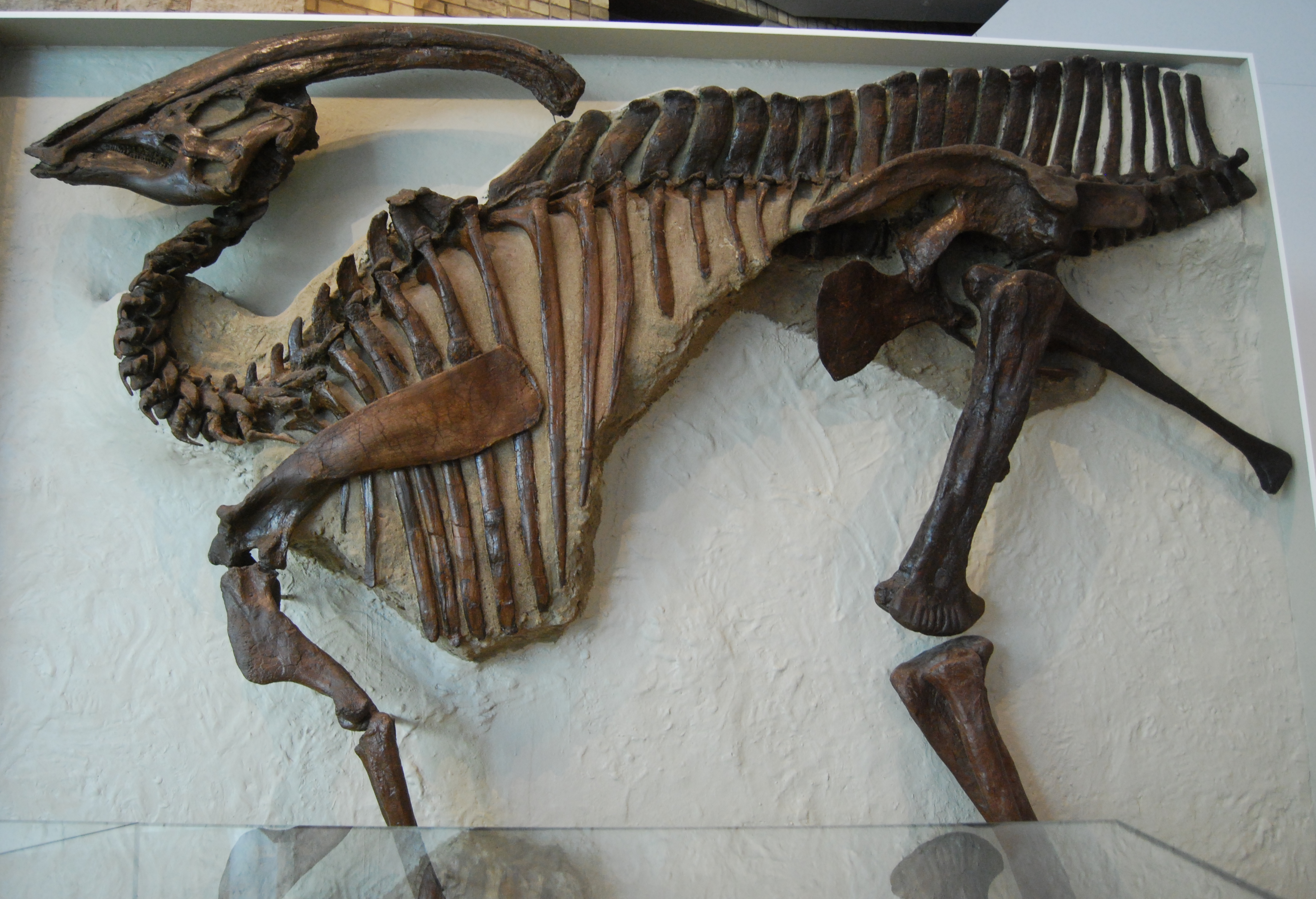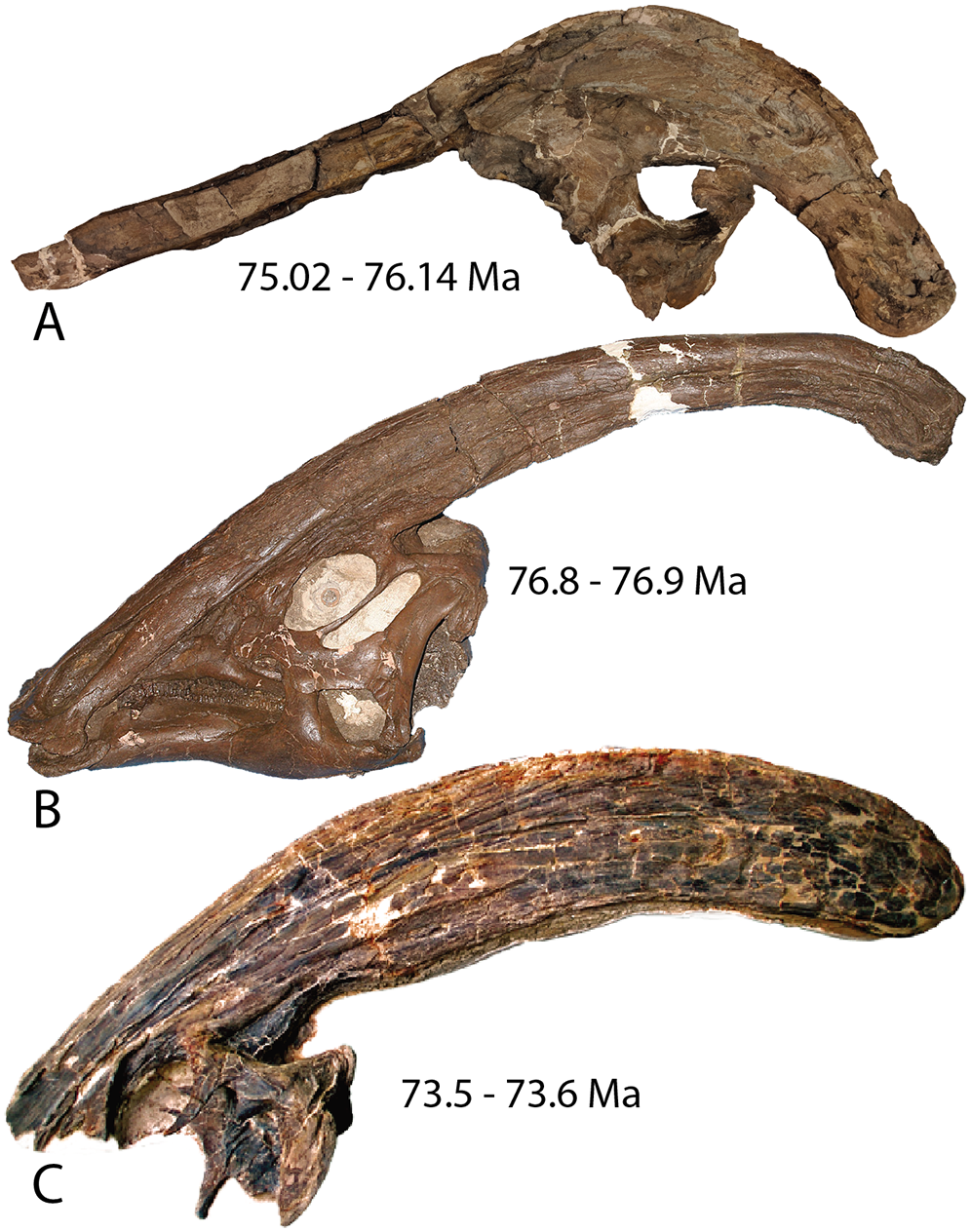|
Lambeosaurinae
Lambeosaurinae is a group of crested hadrosaurid dinosaurs. Classification Lambeosaurines have been traditionally split into the tribes or clades Parasaurolophini (''Parasaurolophus'', ''Charonosaurus'', others (?).) and Lambeosaurini (''Corythosaurus'', ''Hypacrosaurus'', ''Lambeosaurus'', others.). Corythosaurini (synonym of Lambeosaurini, see below) and Parasaurolophini as terms entered the formal literature in Evans and Reisz's 2007 redescription of ''Lambeosaurus magnicristatus''. Corythosaurini was defined as all taxa more closely related to ''Corythosaurus casuarius'' than to ''Parasaurolophus walkeri'', and Parasaurolophini as all those taxa closer to ''P. walkeri'' than to ''C. casuarius''. In this study, ''Charonosaurus'' and ''Parasaurolophus'' are parasaurolophins, and ''Corythosaurus'', ''Hypacrosaurus'', ''Lambeosaurus'', ''Nipponosaurus'', and ''Olorotitan'' are corythosaurins. However, later researchers pointed out that due to the rules of priority set forth b ... [...More Info...] [...Related Items...] OR: [Wikipedia] [Google] [Baidu] |
Pararhabdodon
''Pararhabdodon'' (meaning "near fluted tooth" in reference to ''Rhabdodon'') is a genus of tsintaosaurin hadrosaurid dinosaur, from the Maastrichtian-age Upper Cretaceous Tremp Group of Spain. The first remains were discovered from the Sant Romà d’Abella fossil locality and assigned to the genus ''Rhabdodon'', and later named as the distinct species ''Pararhabdodon isonensis'' in 1993. Known material includes assorted postcranial remains, mostly vertebrae, as well as from the skull. Specimens from other sites, including remains from France, a maxilla previously considered the distinct taxon ''Koutalisaurus kohlerorum'', an additional maxilla from another locality, the material assigned to the genera ''Blasisaurus'' and ''Arenysaurus'', and the extensive Basturs Poble bonebed have been considered at different times to belong to the species, but all of these assignments have more recently been questioned. It was one of the last non-avian dinosaurs known from the fossil record th ... [...More Info...] [...Related Items...] OR: [Wikipedia] [Google] [Baidu] |
Hadrosaurid
Hadrosaurids (), or duck-billed dinosaurs, are members of the ornithischian family Hadrosauridae. This group is known as the duck-billed dinosaurs for the flat duck-bill appearance of the bones in their snouts. The ornithopod family, which includes genera such as ''Edmontosaurus'' and '' Parasaurolophus'', was a common group of herbivores during the Late Cretaceous Period. Hadrosaurids are descendants of the Upper Jurassic/Lower Cretaceous iguanodontian dinosaurs and had a similar body layout. Hadrosaurs were among the most dominant herbivores during the Late Cretaceous in Asia and North America, and during the close of the Cretaceous several lineages dispersed into Europe, Africa, South America and Antarctica. Like other ornithischians, hadrosaurids had a predentary bone and a pubic bone which was positioned backwards in the pelvis. Unlike more primitive iguanodonts, the teeth of hadrosaurids are stacked into complex structures known as dental batteries, which acted as effectiv ... [...More Info...] [...Related Items...] OR: [Wikipedia] [Google] [Baidu] |
Aralosaurus
''Aralosaurus'' was a genus of hadrosaurid dinosaur that lived during the Late Cretaceous in what is now Kazakhstan. It is known only by a posterior half of a skull (devoid of its mandible) and some post-cranial bones found in the Bostobe Formation in rocks dated from the Upper Santonian-Lower Campanian boundary, at about 83.6 Ma (millions of years). Only one species is known, ''Aralosaurus tuberiferus'', described by Anatoly Konstantinovich Rozhdestvensky in 1968. The genus name means Aral Sea lizard, because it was found to the northeast of the Aral Sea. The specific epithet ''tuberiferus'' means bearing a tuber because the posterior part of the nasal bone rises sharply in front of the orbits like an outgrowth. ''Aralosaurus'' was originally reconstituted with a nasal arch similar to that of North American ''Kritosaurus'' (a comparison based on a specimen now placed in the genus ''Gryposaurus''). For many years, ''Aralosaurus'' was thus placed in the clade of the Hadrosaurinae. ... [...More Info...] [...Related Items...] OR: [Wikipedia] [Google] [Baidu] |
Aralosaurini
Aralosaurini is a proposed tribe of hadrosaurid dinosaurs belonging to the subfamily Lambeosaurinae. The members of this group lived in Asia and Europe during the end of the Late Cretaceous about 83.6 to 66.0 million years ago. The clade may not be monophyletic, with ''Canardia'' and ''Aralosaurus'' potentially instead being unrelated primitive members of the subfamily. Description The Aralosaurini are distinguished by their maxilla whose anterior part is elevated dorsally. More precisely, the rostrodorsal region of the bone widens to form a prominent subrectangular flange, which rises vertically above the rostroventral process. ''Aralosaurus'' was previously reconstituted with a nasal boss similar to that of ''Gryposaurus'' and classified as a member of Hadrosaurinae. A new study of the incomplete skull of the animal showed that the fragmentary nasal was in fact a portion of a hollow structure that communicated with the respiratory system. Which is a typical lambeosaurine featur ... [...More Info...] [...Related Items...] OR: [Wikipedia] [Google] [Baidu] |
Parasaurolophus
''Parasaurolophus'' (; meaning "near crested lizard" in reference to '' Saurolophus)'' is a genus of herbivorous hadrosaurid ornithopod dinosaur that lived in what is now North America and possibly Asia during the Late Cretaceous Period, about 76.5–73 million years ago. It was a herbivore that walked both as a biped and as a quadruped. Three species are universally recognized: ''P. walkeri'' (the type species), ''P. tubicen'', and the short-crested ''P. cyrtocristatus''. Additionally, a fourth species, ''P. jiayinensis'', has been proposed, although it is more commonly placed in the separate genus ''Charonosaurus''. Remains are known from Alberta (Canada), New Mexico and Utah (United States), and possibly Heilongjiang (China). The genus was first described in 1922 by William Parks from a skull and partial skeleton found in Alberta. ''Parasaurolophus'' was a hadrosaurid, part of a diverse family of Cretaceous dinosaurs known for their range of bizarre head adornments wh ... [...More Info...] [...Related Items...] OR: [Wikipedia] [Google] [Baidu] |
Lambeosaurinae
Lambeosaurinae is a group of crested hadrosaurid dinosaurs. Classification Lambeosaurines have been traditionally split into the tribes or clades Parasaurolophini (''Parasaurolophus'', ''Charonosaurus'', others (?).) and Lambeosaurini (''Corythosaurus'', ''Hypacrosaurus'', ''Lambeosaurus'', others.). Corythosaurini (synonym of Lambeosaurini, see below) and Parasaurolophini as terms entered the formal literature in Evans and Reisz's 2007 redescription of ''Lambeosaurus magnicristatus''. Corythosaurini was defined as all taxa more closely related to ''Corythosaurus casuarius'' than to ''Parasaurolophus walkeri'', and Parasaurolophini as all those taxa closer to ''P. walkeri'' than to ''C. casuarius''. In this study, ''Charonosaurus'' and ''Parasaurolophus'' are parasaurolophins, and ''Corythosaurus'', ''Hypacrosaurus'', ''Lambeosaurus'', ''Nipponosaurus'', and ''Olorotitan'' are corythosaurins. However, later researchers pointed out that due to the rules of priority set forth b ... [...More Info...] [...Related Items...] OR: [Wikipedia] [Google] [Baidu] |
Parasaurolophus Walkeri
''Parasaurolophus'' (; meaning "near crested lizard" in reference to ''Saurolophus)'' is a genus of herbivorous hadrosaurid ornithopod dinosaur that lived in what is now North America and possibly Asia during the Late Cretaceous Period, about 76.5–73 million years ago. It was a herbivore that walked both as a biped and as a quadruped. Three species are universally recognized: ''P. walkeri'' (the type species), ''P. tubicen'', and the short-crested ''P. cyrtocristatus''. Additionally, a fourth species, ''P. jiayinensis'', has been proposed, although it is more commonly placed in the separate genus ''Charonosaurus''. Remains are known from Alberta (Canada), New Mexico and Utah (United States), and possibly Heilongjiang (China). The genus was first described in 1922 by William Parks from a skull and partial skeleton found in Alberta. ''Parasaurolophus'' was a hadrosaurid, part of a diverse family of Cretaceous dinosaurs known for their range of bizarre head adornments whi ... [...More Info...] [...Related Items...] OR: [Wikipedia] [Google] [Baidu] |
Lambeosaurini
Lambeosaurini, previously known as Corythosaurini, is one of four tribes of hadrosaurid ornithopods from the family Lambeosaurinae. It is defined as all lambeosaurines closer to ''Lambeosaurus lambei'' than to ''Parasaurolophus walkeri, Tsintaosaurus spinorhinus, or Aralosaurus tuberiferus'', which define the other three tribes. Members of this tribe possess a distinctive protruding cranial crest. Lambeosaurins walked the earth for a period of around 12 million years in the Late Cretaceous, though they were confined to regions of modern-day North America and Asia. History of classification The term Corythosaurini was first used by Brett-Surman in 1989, who characterized the taxon via reference to the premaxilary expansion into a hollow helmet-like cranial crest, as well as higher neural spines. The clade was formally defined via phylogenetic analysis by Evans and Reisz in 2007, and this was confirmed by multiple other analyses. In 2011, Sullivan ''et al.'' observed that by the r ... [...More Info...] [...Related Items...] OR: [Wikipedia] [Google] [Baidu] |
Arenysaurini
Arenysaurini is a proposed tribe of primitive lambeosaurine hadrosaurs. It is composed of genera found in Europe and North Africa during the end of the Cretaceous period, and has been suggested to unite all lambeosaurs from the former continent into a singular monophyletic group. Description Hadrosaurs were a group of herbivorous dinosaurs capable of walking on two or four legs, possessing beaks and complex batteries of teeth; members of Arenysaurini, being of the lambeosaurine lineage of Hadrosauridae, would have possessed large crests on their skulls made up of arrays of nasal passages. Multiple anatomical traits of the skull and teeth unite some or all potential members of Arenysaurini; a mixture of traits seen in primitive and derived lambeosaurs is observed. Examples of primitive traits include a short and a broad dorsal process (bony production) on the maxilla, reduced extensively in derived lambeosaurs. Additionally, several traits distinguish arenysaurs from other lambeos ... [...More Info...] [...Related Items...] OR: [Wikipedia] [Google] [Baidu] |
Tsintaosaurini
Tsintaosaurini is a tribe of basal lambeosaurine hadrosaurs native to Eurasia. It is thought to contains the genera ''Tsintaosaurus'' (from China), ''Pararhabdodon'' (from Spain) and '' Koutalisaurus'' (also from Spain), though some studies have questioned its existence as a natural grouping. Classification Tsintaosaurini is part of the family Hadrosauridae, specifically the subfamily Lambeosaurinae. The existence of a tsintaosaur clade of lambeosaurines was first recognized by palaeontologists Albert Prieto-Márquez and Johnathan R. Wagner, who in 2009 published a paper recognizing a phylogenetic relationship between ''Tsintaosaurus'' and ''Pararhabdodon'' based both on shared anatomical traits and a phylogenetic analysis. A 2013 study by Prieto-Márquez corroborated the existence of this grouping, and coined the tribe Tsintaosaurini to refer to it. The type genus is ''Tsintaosaurus'', and it was defined as the smallest clade containing ''Tsintaosaurus spinorhinus'' and ''Para ... [...More Info...] [...Related Items...] OR: [Wikipedia] [Google] [Baidu] |
Lambeosaurus Lambei
''Lambeosaurus'' ( , meaning " Lambe's lizard") is a genus of hadrosaurid dinosaur that lived about 75 million years ago, in the Late Cretaceous period (Campanian stage) of North America. This bipedal/quadrupedal, herbivorous dinosaur is known for its distinctive hollow cranial crest, which in the best-known species resembled a mitten. Several possible species have been named, from Canada, the United States, and Mexico, but only the two Canadian species are currently recognized as valid. Material relevant to the genus was first named by Lawrence Lambe in 1902. Over twenty years later, the modern name was coined in 1923 by William Parks, in honour of Lambe, based on better preserved specimens. The genus has a complicated taxonomic history, in part because small-bodied crested hadrosaurids now recognized as juveniles were once thought to belong to their own genera and species. Currently, the various skulls assigned to the type species ''L. lambei'' are interpreted as showin ... [...More Info...] [...Related Items...] OR: [Wikipedia] [Google] [Baidu] |
Lambeosaurus
''Lambeosaurus'' ( , meaning " Lambe's lizard") is a genus of hadrosaurid dinosaur that lived about 75 million years ago, in the Late Cretaceous period (Campanian stage) of North America. This bipedal/quadrupedal, herbivorous dinosaur is known for its distinctive hollow cranial crest, which in the best-known species resembled a mitten. Several possible species have been named, from Canada, the United States, and Mexico, but only the two Canadian species are currently recognized as valid. Material relevant to the genus was first named by Lawrence Lambe in 1902. Over twenty years later, the modern name was coined in 1923 by William Parks, in honour of Lambe, based on better preserved specimens. The genus has a complicated taxonomic history, in part because small-bodied crested hadrosaurids now recognized as juveniles were once thought to belong to their own genera and species. Currently, the various skulls assigned to the type species ''L. lambei'' are interpreted as showi ... [...More Info...] [...Related Items...] OR: [Wikipedia] [Google] [Baidu] |








